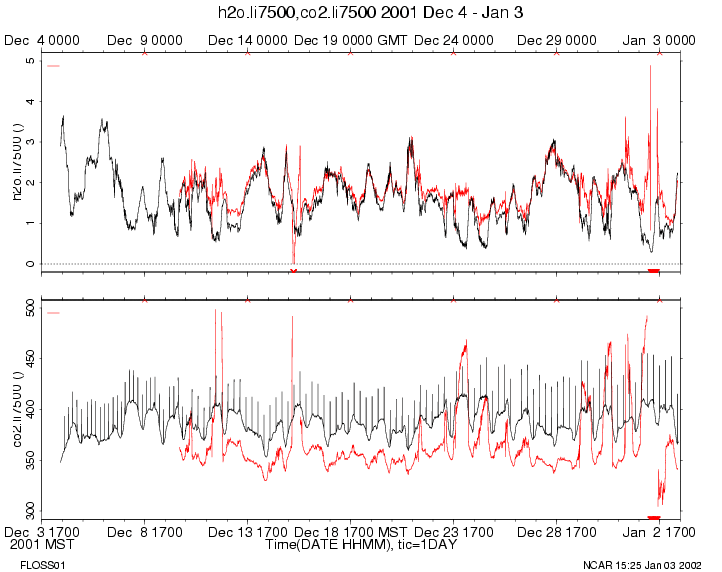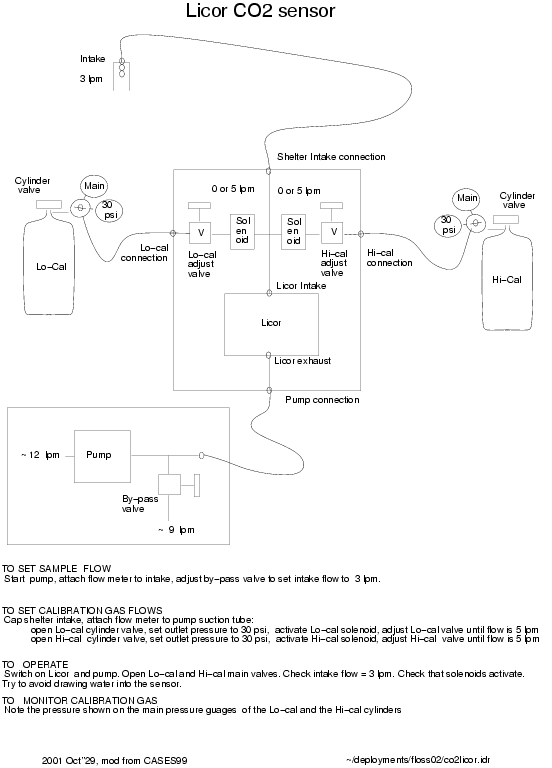| Graphic: | 
Here is what I think the Li7500 is reporting (I guess they are using g-moles):
H2OD - mmol/m3
convert to mass mixing ratio by:
H2OD (mmol/m3) * 0.001 (mol/mmol) * 18 (g_H2O/mol_H2O) / rho.air (kg_air/m3)
CO2D - umol/m3???
convert to ppmV by:
CO2D (mmol/m3) * 1000 (umol/mmol) * 28.97 (g_air/mol_air) * 0.001 (kg_air/g_air)
/ rho.air (kg_air/m3)
A plot of values converted this way is attached. H2OD is compared to Q and
CO2D is compared to co2mr. Everything seems in the right ballpark.
85: CO2, Site tower, Mon 10-Dec-2001 11:02:03 MST, new licor7500 converter
On Dec 10, 09:36 MST cosmos was rebooted to install a
new sio_converter for the licor 7500 on channel 212.
Up until 09:36 we were using noconv_nl as the sio_converter
for the licor, which does no conversion and passes the
ASCII to the cal routine (licor_7500) to parse.
For efficency sake, were now using this sio_converter:
licor_7500 9 "(Data (Ndx %f)(CO2Raw %f)(CO2D %f)(H2ORaw %f)(H2OD %f)(Temp %f)(Pres
%f)(Aux %f)(Cooler %f))"
The cal routine is then the generic serial_float, though I imagine
we may have to create a special one if we want to convert the
units.
The licor periodically (once a second?) puts out a diagnostic
record, which will be ignored (and not archived). To see
the diagnostic record in real-time use rserial.
73: CO2, Site tower, Sat 08-Dec-2001 14:21:45 MST, li7500 up
I mounted OSU's LI-7500 yesterday about 2pm and connected it to cosmos:212.
We are archiving the data in unconverted ASCII until we can figure out a
different format.
I don't like the mounting for the LiCor's box. Currently, I have it just
sitting on a breakout box stand. At the very least, it should be bolted to
this stand....
I also did some CONFUSING cabling for this sensor. I have connected it to
MARIGOLD's Serial/Analog breakout box, to avoid adding another BOB. My
primary reason was to avoid running more DC power cable, since the LiCor takes
2 AMPS. A secondary reason was that we might connect it to marigold later
anyway, if Larry decides to move this sensor to 10m.
We still need to parse the message from this sensor. I've just put a generic
prep.config entry in for this sensor, commented out.
65: CO2, Site tower, Thu 06-Dec-2001 16:50:19 MST, flow rates checked
I just did the flow rate checks that Tony suggested. Each cal gas was turned
on for about 30 seconds at about 16:25. Note that I was standing near the
sonic during this period, so all fluxes at 2m are suspect.
nominal flow rate is ~5.5 lpm
flow rate with cylinder 1 is ~-2 lpm
flow rate with cylinder 3 is ~-2.5 lpm
These readings were so close to what Tony intended that I didn't change
anything.
But we still don't know why his gas is being used up relatively fast. I can
think of several possibilities:
- The flow rate out of the pressurized cylinders is more than through the
scintered inlet. I could check this by metering the analyzer outflow.
- There is a leak in the cal gas line. This strikes me as unlikely since both
cylinders are going down at about the same rate.
60: CO2, Site tower, Thu 06-Dec-2001 12:26:23 MST, CO2 installation
The Licor aspirated CO2 system was installed on 30 Nov''01
The configuration is shown in ...../doc/co2licor.idr (to be copied from
~/deploymnets/floss02/co2licor.idr)
lico2.2m cosmos 102
li.2m cosmos 103
Channel 0 Channel 1
Ambient off off
Lo-cal on Off
Hi-cal off on
Sequence of 2 minutes Lo-cal, 2 minutes of Hi-cal, 4 Hr 56 minutes of Ambient,
repeating every 5 hrs
was initiated.
The system was tested on 1 dec''01.
Lo-cal and Hi-cal were activated and a Zero can period was run.
The Flows were checked with a floating ball meter.
5 lpm intake during ambient flow.
Adjusted using bypass valve on pump suction manifold.
~2 lpm backflow during both Lo-cal and Hi-cal periods.
Adjusted using cross handle, very sensitive, for lo-cal
and using knob, for hi-cal
Set a default calibration factor of 180 ppmv/volt to generate an approximately
correct mixing ratio
Keeping track of cal gas usage
58: CO2, Site tower, Thu 06-Dec-2001 12:23:08 MST, cal gases
- Previous -
Next -
Index
| Graphic: | 
On 8 Nov''01 six cylinders of synthetic air/CO2 were cross calibrated with a CMDL
standard at CUFF.
Cal1 AK-170118 317 ppmv
Cal2 220K-0017 315 ppm
Cal3 LK58629 484 ppmv
Cal4 LK285067 495 ppmv
Cal5 291120Y 493 ppmv
Cal6 220K-0002 324 ppmv
Cal5 and Cal6 remain at FLAB
Cal1, Cal2 , the Lo-cal cylinders, and Cal3, Cal4. the Hi-cal cylinders are at the
tower base.
Cal1=Lo-cal and Cal3=Hi-cal were connected Sat 01 Dec''01
Cal2=Lo-cal and Cal4=Hi-cal are in reserve, laying next to the active cylinders.
- 50: CO2, Site tower, Wed 05-Dec-2001 12:11:51 MST, co2 calibration
I just looked at the CO2 calibration on 5 Dec 02:00. From an eyeball average
of values from prep, using a default gain of 190 and bias of 0:
cyl #1 - 317 => 334
cyl #3 - 484 => 472
Thus, the gain would be: 190 * (484-317)/(472-334) = 230
and the offset would be: 317 - 334*230/190 = -87
I'll go ahead and put these in, though we expect to generate a time-varying
calibration eventually.
- 38: CO2, Site tower, Tue 04-Dec-2001 11:16:59 MST, cal gas values
calibrations from Niwot Ridge site:
cal 1 317
cal 2 315
cal 3 484
cal 4 495
cal 5 493
cal 6 324 ppmV
We are currently using cylinders 1 and 3.
Bill Massman and John ? are now sniffing these as well.
- 33: CO2, Site tower, Mon 03-Dec-2001 13:15:09 MST, cal gas amounts
We'll start to keep track of cal gas amounts here:
Cal 1(Lo) Cal 3(Hi)
01 Dec 20/1750 20/1630
03 Dec ?/1710 ?/1610
04 Dec 22/1610 19/1595 (~10:30; before Massman)
04 Dec 22/1590 20/1480 (~16:30; well after Massman)
06 Dec 22/1400 20/1410
07 Dec 22/1360 20/1400
08 Dec 22/1250 20/1330
09 Dec 22/1200 20/1300
10 Dec 22/1120 20/1290
- 23: CO2, Site tower, Sat 01-Dec-2001 17:19:58 MST, licor CO2 cal gas sequence
The co2 calibration is controlled by the ttl program in channel config:
# Tony wants a 2 minute calibration every 5 hours
# 17880 secs = 4 hours, 58 minutes
#
# adam datel_ttl_output unit chan start on off
#
cosmos datel_ttl_output 0 0 00:00:00 120 17880
cosmos datel_ttl_output 0 1 00:02:00 120 17880
TTL channel 0 controls the low cal gas valve, channel 1 controls
the high cal gas valve.
The low cal gas is 317 ppmV CO2, the high is 484 ppmV.
After cosmos is booted, it performs its first calibration at the
next multiple of 5 hours from 00:00 GMT of the current day, which
is at 05:00, 10:00, 15:00, 20:00 GMT or 01:00 the next day.
The sequence then repeats every 5 hours.
So assuming cosmos was booted at 17:00 GMT, the following sequence
would occur:
20:00 low cal gas
20:02 high cal gas
20:04 ambient air until 01:00 next day.
The next day the cal times will be an hour later:
01:00 same cal sequence
06:00
etc
Cosmos was last booted yesterday, Nov 30.
Tony connected the licor this morning, Dec 1.
I verified in the high rate co2mr.2m data that the calibration
sequence was done at 21:00 GMT today.
|
|

